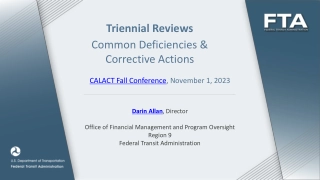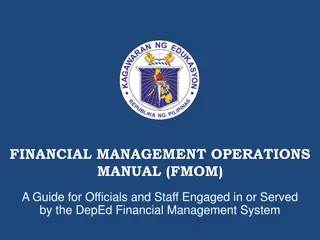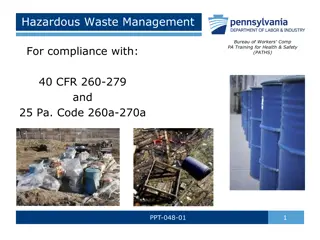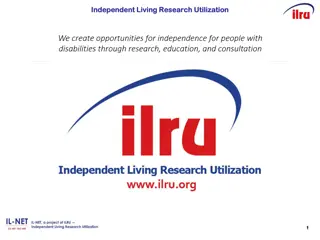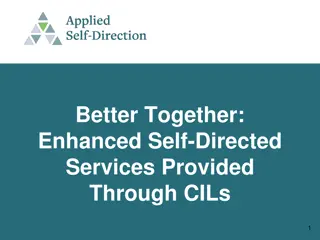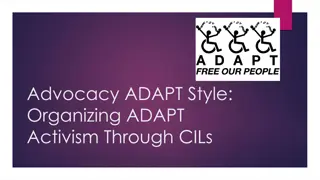Financial Management Workshop for CILs Regulations and Beyond
Workshop in Baltimore, Maryland focusing on financial management for Centers for Independent Living. Presenters cover topics like indirect cost rate proposals, exemptions, understanding indirect cost rates, allowable costs, and unallowable costs as per Uniform Guidance.
Download Presentation

Please find below an Image/Link to download the presentation.
The content on the website is provided AS IS for your information and personal use only. It may not be sold, licensed, or shared on other websites without obtaining consent from the author.If you encounter any issues during the download, it is possible that the publisher has removed the file from their server.
You are allowed to download the files provided on this website for personal or commercial use, subject to the condition that they are used lawfully. All files are the property of their respective owners.
The content on the website is provided AS IS for your information and personal use only. It may not be sold, licensed, or shared on other websites without obtaining consent from the author.
E N D
Presentation Transcript
Financial Management: Financial Management: Workshop for CILs Regulations and for CILs Regulations and Beyond Workshop Beyond Baltimore, Baltimore, Maryland May 25 May 25- -27, 2016 27, 2016 Maryland Presenters: John Heveron, Jr. CPA John Heveron, Jr. CPA Heveron & Company, CPAs Paula Paula McElwee McElwee IL-NET Steven Spillan, Esq. Steven Spillan, Esq. Brustein & Manasevit, PLLC 11
Preparing An Indirect Cost Rate Preparing An Indirect Cost Rate Proposal Proposal 2
Who Does Not Need to Submit an Who Does Not Need to Submit an Indirect Cost Rate Proposal? Indirect Cost Rate Proposal? Organizations with only one cost objective, even if there are multiple funders for that cost objective, may be exempt. Fundraising is an additional cost objective. Organizations that can allocate everything directly to each of their cost objectives, and can prove it! Organizations that are eligible for and do elect a 10% reimbursement for indirect costs will not need an indirect cost rate. 3
What is an Indirect Rate Proposal? What is an Indirect Rate Proposal? An indirect cost rate proposal is similar to a Cost Allocation Plan. It includes an additional requirement to calculate a preliminary or provisional rate of indirect cost near the beginning of the year, and reports the actual rate after the end of the year. Costs are classified as direct (benefiting one of your programs or other activities such as fundraising), or indirect (benefiting all programs and therefore shared or split fairly between those programs). Most CILs will treat general and administrative costs as indirect costs. 4
What is an Indirect Cost Rate? What is an Indirect Cost Rate? General administrative and general expenses include costs such as a receptionist, bookkeeper or accountant, rent and utilities for your business office and similar items that benefit all programs. Organizations that don t have a current approved indirect cost rate, and don t elect the 10% reimbursement, may be denied any indirect cost reimbursement. Funders may continue to require a breakout of costs by funding source even if the services and the consumers are the same. 5
Allowable and Unallowable Costs Allowable and Unallowable Costs Only costs that are allowable, in accordance with Uniform Guidance, can be charged to programs. An alphabetical list of many different types of costs, with information about whether they are or may be unallowable can be found starting at section 200.420 http://www.ecfr.gov/cgi-bin/text- idx?SID=416cff3dabc2084c6576a12b06b09006&mc=true&no de=sg2.1.200_1419.sg16&rgn=div7 6
Unallowable Costs Unallowable Costs These costs are identified as unallowable in Uniform Guidance and can t be paid with federal funding. They include: alcoholic beverages bad debts certain advertising contributions certain entertainment fines and penalties, and lobbying. These unallowable costs cannot be charged to programs that are entirely or partially federally funded. 7
Allocating Salary Costs Allocating Salary Costs Executive Director s time/salary and fringe costs may be both direct and indirect. Direct costs are shared between the benefiting cost objectives based on actual time records. A Program Manager s time/salary and fringe costs are shared between all the cost objectives based on actual time records. General and administrative salaries such as the receptionist, the accounting staff, and a portion of the Executive Director salary will be indirect. 8
Components of an Indirect Cost Rate Components of an Indirect Cost Rate Proposal Proposal Your indirect cost rate proposal to HHS will include An introduction to your organization with background information. An explanation of how you allocate costs. A schedule of federal funding you receive. A schedule of Payroll and Related Costs. A schedule of Direct and Indirect Costs with a calculation of the indirect cost rate % (see example). A reconciliation to your financial statements or 990. A Certification about the accuracy of the proposal. A lobbying Cost Certificate. 9
How to submit your indirect cost rate How to submit your indirect cost rate proposal proposal HHS requires that all indirect cost rate proposals be submitted electronically. They require two separate PDF files (CD or flash drives if file size exceeds 25 MB). The first file marked proposal will contain the entire proposal including your transmittal letter checklists and certifications as well as supporting schedules. The second file, marked financial statements will contain financial information such as audited financial statements or your annual form 990. Go to https://rates.psc.gov/fms/dca/map1.html to find the regional office where you will submit your proposal. 10
One Size Doesn't Fit All One Size Doesn't Fit All The following example is for a relatively simple CIL, we call PENN CIL, with a limited number of cost objectives and a limited number of funding sources. The example uses a simplified allocation method, which is appropriate where your cost objectives benefit from indirect costs to approximately the same degree. It also follows the direct allocation method which treats all costs as direct except general and administrative expenses. 11
Introduction Introduction There is no set format for the introduction, but it should describe your organization with information such as Your legal and any DBA or known name. Your business office location and any other locations. The population you serve. The services you provide. The primary funding sources you receive. Your legal structure and governance (nonprofit corporation governed by an independent board). The approximate FTE staff size of your organization. Whether you own or lease your facility and an approximate size of the facility. 12
Description of How Costs are Allocated Description of How Costs are Allocated You must accurately describe how you allocate costs. The following format is typical. EXAMPLE PENN CIL follows US generally accepted accounting principles and uses the accrual method of accounting. The general approach of PENN CIL in allocating costs to particular grants and contracts is as follows: All allowable direct costs are charged directly to cost objectives, program grants, activities, etc. 13
Description of How Costs are Description of How Costs are Allocated, Allocated, cont d. cont d. If an allowable direct cost benefits more than one cost objective, it is assigned directly to the cost objectives that benefit based on the level of benefit they receive. All other allowable indirect costs (costs that benefit all cost objectives and cannot be identified to a specific cost objective) are pooled(combined) and allocated to cost objectives, grants, etc. based on direct costs for each cost objective, except as noted below. 14
Description of How Costs are Description of How Costs are Allocated, Allocated, cont d. 2 cont d. 2 EXAMPLE cont d. The following information summarizes the procedures used by PENN CIL, Inc. beginning October 1, 2016. Payroll and Related Costs Payroll costs are documented with timesheets and personnel activity reports (PARs) showing time distribution for all employees. Payroll costs are assigned to cost objectives based on actual work done. Payroll is charged directly to the cost objective for which services have been performed. Payroll costs that benefit all cost objectives are pooled and allocated as explained above. 15
Description of How Costs are Description of How Costs are Allocated, Allocated, cont d. cont d. 3 3 Payroll and Related costs, cont d. Payroll taxes and fringe benefits (FICA, Unemployment Compensation, and Worker s Compensation costs) are assigned in the same manner as salaries and wages. Health insurance, dental insurance, life and disability, and other fringe benefits are also allocated in the same manner as salaries and wages. Vacation, holiday, and sick pay are assigned in the same manner as salaries and wages. 16
Description of How Costs Description of How Costs are Allocated, Allocated, cont d. 4 cont d. 4 are Rent and Utilities occupancy costs are charged to individual cost objectives/activities based on square footage used by each cost objective or activity. Facilities costs that benefit all cost objectives are included with general and administrative, and allocated as described above. Other Allowable costs that benefit single or multiple cost objectives are assigned directly to those cost objectives. Costs that benefit all cost objectives are included with general and administrative, and allocated as described above. 17
Schedule Schedule of Federal of Federal Funding Funding PENN CIL Schedule of federal awards: (example) Grantor Passthru CFDA# 2014 Total $ Expenditures Period of Perf. Health and Human Services 84.132A $400,000 $400,000 10/1/16 9/30/17 Social Security 96.008 $ 90,000 $390,000 7/1/15 6/30/16 Department of Labor NY State 96.630 $150,000 $150,000 7/1/15 6/30/16 18
PENN CIL Attachment E PENN CIL Attachment E Schedule of Payroll & Related Costs (example Schedule of Payroll & Related Costs (example) ) Projected Payroll, Payroll Overhead and Indirect Allocation Projected Payroll, Payroll Overhead and Indirect Allocation 19
Illustration of an Indirect Rate Illustration of an Indirect Rate Calculation (example) Indirect Costs Payroll 122,750 Payroll OH 19,183 Outside Services 5,900 Rent 5,100 Utilities 1,270 Maintenance 2,600 Travel and Training 800 Depreciation 4,648 Telephone 7,572 Insurance 6,586 Dues and Subscriptions 3,500 Advertising 3,660 Office Supplies & Exp. 1,974 Other Exp. 3,057 TOTAL $188,600 Calculation (example) Direct Costs Payroll Payroll OH Outside Services 42,587 Rent Utilities Maintenance Travel and Training cost objective Supplies 27,652 TOTAL 510,750 79,820 102,757 11,597 37,580 46,892 $859,635 Indirect Cost Rate 188,600/859,635 = 21.9% 20
CIL CIL- -NET NET Attribution Attribution Support for development of this technical assistance information was provided by the Department of Health and Human Services, Administration for Community Living under grant number 90TT0001-02-00. No official endorsement of the Department of Health and Human Services should be inferred. Permission is granted for duplication of any portion of this information, providing that the following credit is given to the project: Developed as part of the IL-NET, an ILRU/NCIL/APRIL National Training and Technical Assistance Program. 21



